PART 3
Chance Encounter on the Street
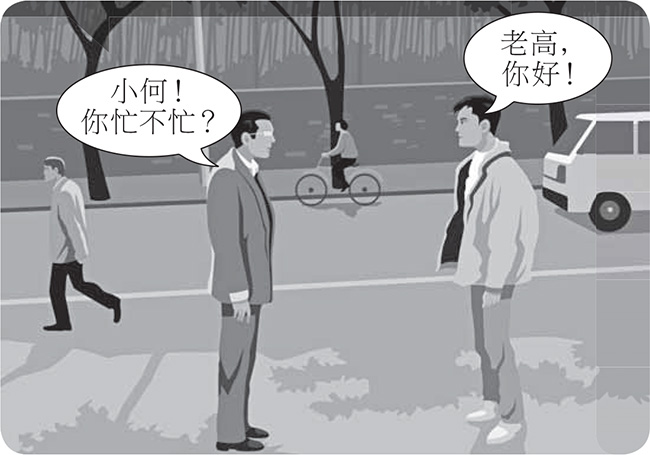
New Characters and Words 
Study the six characters below and the common words written with them, paying careful attention to each character’s pronunciation, meaning, and structure, as well as similar-looking characters. After you’ve studied a character, turn to the Practice Book volume and practice writing it on the practice sheet, making sure to follow the correct stroke order and direction as you pronounce it out loud and think of its meaning.
61 |
老 |
lăo |
old |
老 is itself a radical. 老 can also serve as a phonetic, e.g., in 姥 lăo as in 姥姥 lăolao “maternal grandmother.” The character 老 was originally a picture of an “old” man with a walking stick. Contrast 老 and 去 qù (53). |
|||
老 |
Lăo |
Lao, Lau [SN] |
|
老 |
lăo |
be old [SV] |
|
老王 |
Lăo Wáng |
Old Wang |
|
62 |
高 |
gāo |
tall, high |
高 is itself a radical. 高 can also serve as a phonetic in other characters, e.g., in 膏 gāo as in 牙膏 yágāo “toothpaste,” 搞 găo “do, make,” and 稿 găo as in 稿子 găozi “manuscript.” As a mnemonic, think of the character 高 as depicting a “tall” pavilion or tower. |
|||
高 |
gāo |
be tall, high [SV] |
|
高 |
Gāo |
Gao, Kao (also Go, Ko, or Koh, a common Korean surname) [SN] |
|
老高 |
Lăo Gāo |
Old Gao |
|
63 |
不 |
bù |
not |
Radical is 一 yī (1). This character can be explained as showing the sky (represented by 一) and a bird flying up to it but “not” being able to get there. In handwriting, the first two strokes of this character are often connected. Contrast 不 and 上 shàng (25). |
|||
不 |
bù |
not [A] |
|
不忙 |
bù máng |
not busy |
|
不高 |
bù gāo |
not tall |
|
64 |
太 |
tài |
excessively |
Radical is 大 dà (13). 太 is itself a phonetic, e.g., in 钛 ( 鈦 ) tài “titanium,” 态 ( 態 ) as in 态度 ( 態度 ) tàidu “attitude,” and 汰 as in 淘汰 táotài “eliminate.” The character 太 is formed by adding a stroke under the character 大, which itself already means “big,” and so 太 has the meaning “excessively” or “too” something. Contrast 太 with 人 rén (30), 大 dà (13), and 不 bù (63). |
|||
太 |
tài |
excessively, too [A] |
|
太忙 |
tài máng |
too busy |
|
不太高 |
bú tài gāo |
not too tall |
|
65 |
难(難) |
nán |
difficult |
Radical is 隹 zhuī “short-tailed bird” [BF]. The whole character can serve as a phonetic, e.g., in 摊 (攤) as in 摊子 (攤子) tānzi “vendor’s stall” or in 滩 (灘) as in 海滩 (海灘) hăitān “beach.” |
|||
难 |
(難) nán |
be difficult, hard [SV] |
|
66 |
谢(謝) |
xiè |
thank |
Radical is 讠 (言) yán “speech” [BF]. The colloquial name for this radical is 言字旁 yánzìpáng “side made up of the character 言.” The rest of 谢 (謝) consists of the character 射 shè “shoot forth,” which is here also the phonetic. The idea is that “words” of “thanks” are “shooting forth” from the mouth of the person saying them. |
|||
谢 |
(謝) Xiè |
Xie, Hsieh [SN] |
|
谢谢 (謝謝) |
xièxie |
“thank you” [IE] |
|
New Words in BMC–SL 1-3 Written with Characters You Already Know 
小 |
xiăo |
be small, little, young [SV] |
何 |
Hé |
He, Ho [SN] |
小何 |
Xiăo Hé |
Little He |
中文 |
Zhōngwén |
Chinese language [N] |
Reading Exercises (Simplified Characters) 
Now practice reading the new characters and words for this lesson in context in sentences, conversations, and narratives. Be sure to refer to the Notes at the end of this lesson, and make use of the accompanying audio disc to hear and practice correct pronunciation, phrasing, and intonation.
A. SENTENCES
Read out loud each of the following sentences, which include all the new characters of this lesson. The first time you read a sentence, focus special attention on the characters and words that are new to you, reminding yourself of their pronunciation and meaning. The second time, aim to comprehend the overall meaning of the sentence.
一、老高,谢谢!小何,谢谢!
二、林文生很高吗?
三、小何很高,你也很高。
四、林一明,香山好不好?去香山难不难?
五、你不去台湾吗?我也不去台湾。
六、她们太忙,她们不去。你呢?你去不去?
七、她很老,她们都很老。
八、小明太小吗?他不小!
九、中文难不难?
十、王大海不太忙。
B. CONVERSATIONS
Read out loud the following conversations, including the name or role of the person speaking. If possible, find a partner or partners and each of you play a role. Then switch roles, so you get practice reading all of the lines.
一、
小高:老李!
老李:小高!你忙不忙?
小高:不忙,不忙。你呢?
老李:我也不太忙。
二、
小何:老王,你好!
老王:小何,你好!
小何:你忙不忙?
老王:我很忙。
小何:你去不去北京?
老王:我太忙,不去。你去不去?
小何:我也不去。
三、
王大山:林京生!
林京生:王大山!
王大山:你好吗?
林京生:我很好,谢谢!你呢?
王大山:我很忙。我去西安,你去不去?
林京生:我也去西安。去西安难不难?
王大山:去西安不太难。
林京生:很好,很好。
C. CHARACTER DIFFERENTIATION DRILLS
Distinguish carefully the following similar-looking characters, pronouncing each one out loud and thinking of its meaning.
一、老 老 老 去 去 去
二、老 去 去 老 去 老 老
三、太 太 太 大 大 大
四、太 太 太 人 人 人
五、太 大 人 太 大 大 太 人
D. NARRATIVES
Read the following narratives, paying special attention to punctuation and overall structure. The first time you read a narrative, read it out loud; the second time, read silently and try to gradually increase your reading speed. Always think of the meaning of what you’re reading.
一、 |
小金,去天津街难不难?不太难吗?好。去上海路难不难?很难吗?好,我去天津街,不去上海路。小金,你很好,谢谢! |
二、 |
北京人很高吗?北京人很高。山东人呢?山东人也很高。上海人高不高?上海人不太高。广东人、台湾人呢?广东人、台湾人也都不太高。 |
Reading Exercises (Traditional Characters) 
A. SENTENCES
Read out loud each of the following sentences, which include all the new characters of this lesson. The first time you read a sentence, focus special attention on the characters and words that are new to you, reminding yourself of their pronunciation and meaning. The second time, aim to comprehend the overall meaning of the sentence.
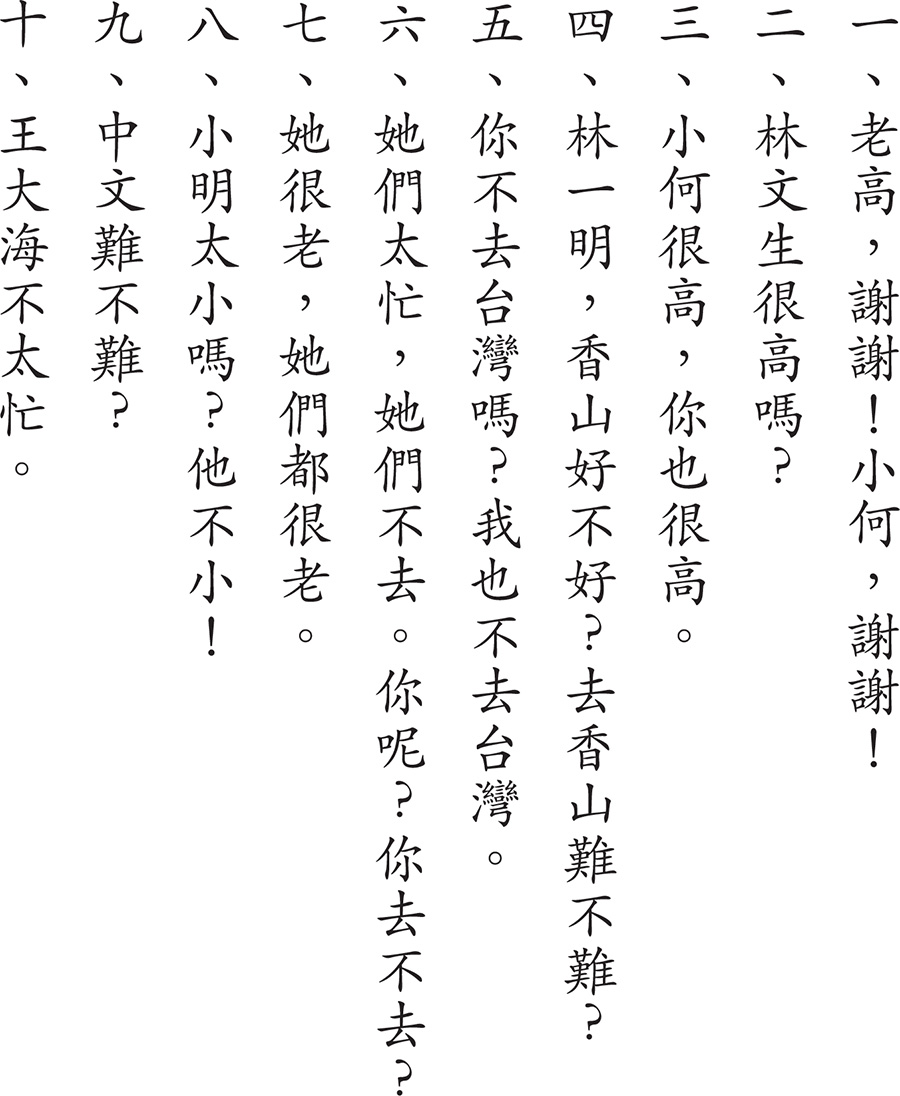
B. CONVERSATIONS
Read out loud the following conversations, including the name or role of the person speaking. If possible, find a partner or partners and each of you play a role. Then switch roles, so you get practice reading all of the lines.
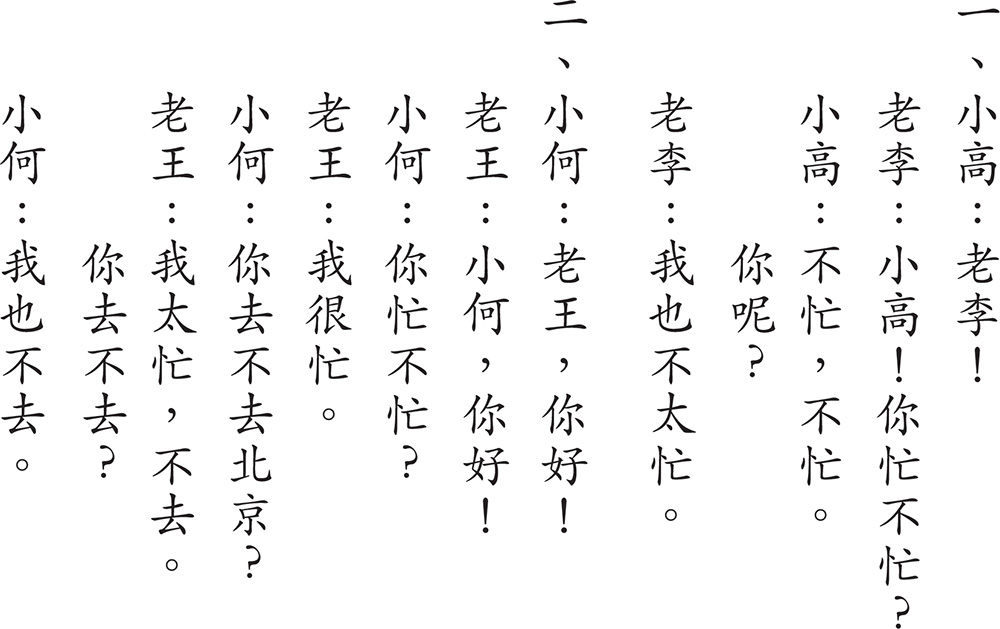
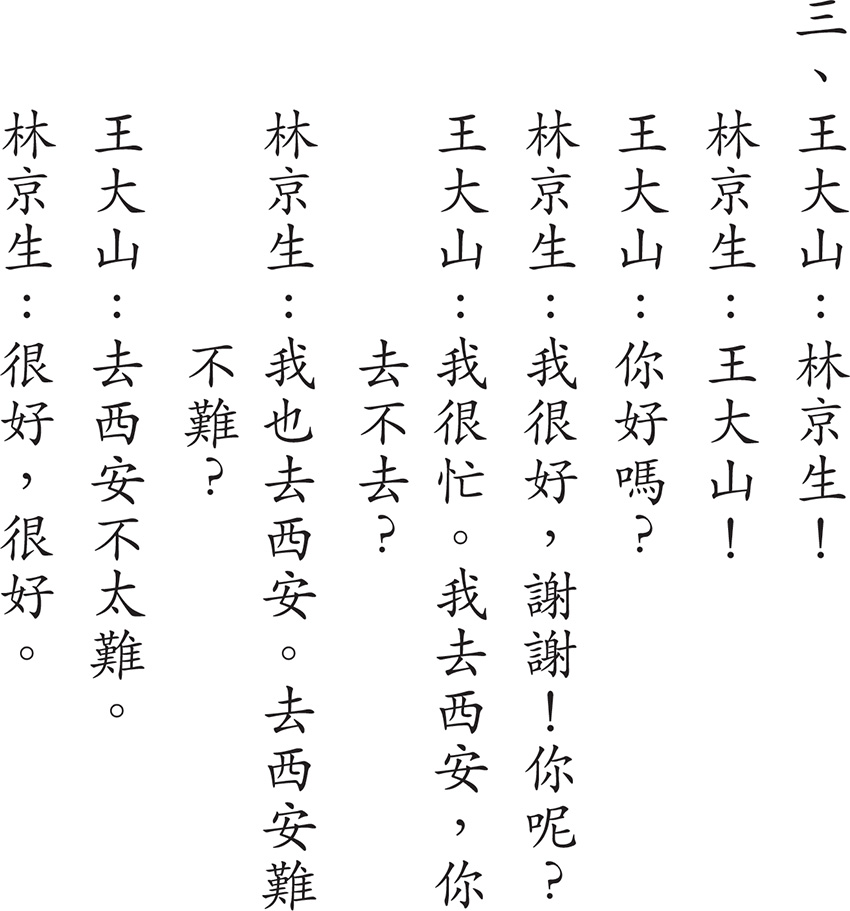
C. CHARACTER DIFFERENTIATION DRILLS
Distinguish carefully the following similar-looking characters, pronouncing each one out loud and thinking of its meaning.

D. NARRATIVES
Read the following narratives, paying special attention to punctuation and overall structure. The first time you read a narrative, read it out loud; the second time, read silently and try to gradually increase your reading speed. Always think of the meaning of what you’re reading.
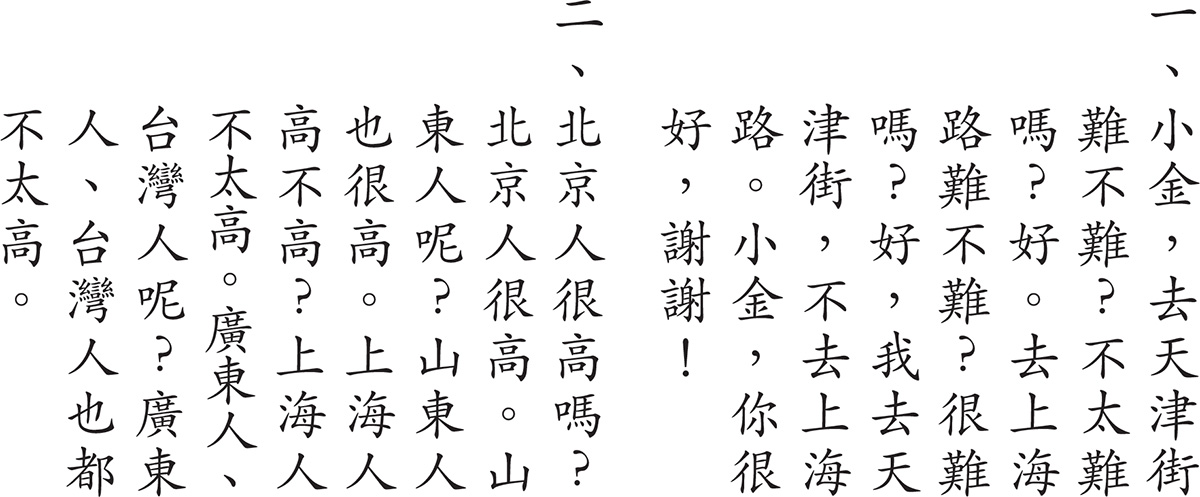
Notes
A10. The expression 不太好 here means “is not doing very well.”
B3. Note that the first two lines of this conversation consist of nothing other than each speaker’s name: 林京生!王大山! Calling out someone’s name in this manner is a common type of informal greeting.
D2. This description of the relative heights of Chinese people from different regions is greatly simplified due to vocabulary limitations.